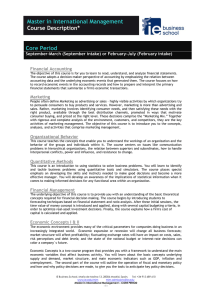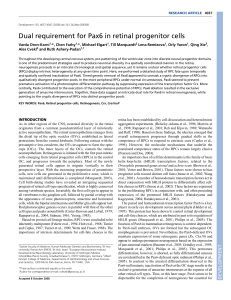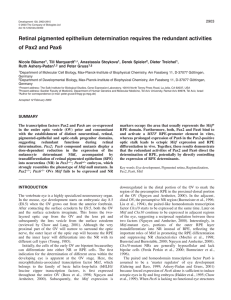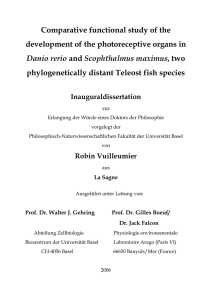PAX6 peptide ab5895 Product datasheet 2 References Overview
advertisement
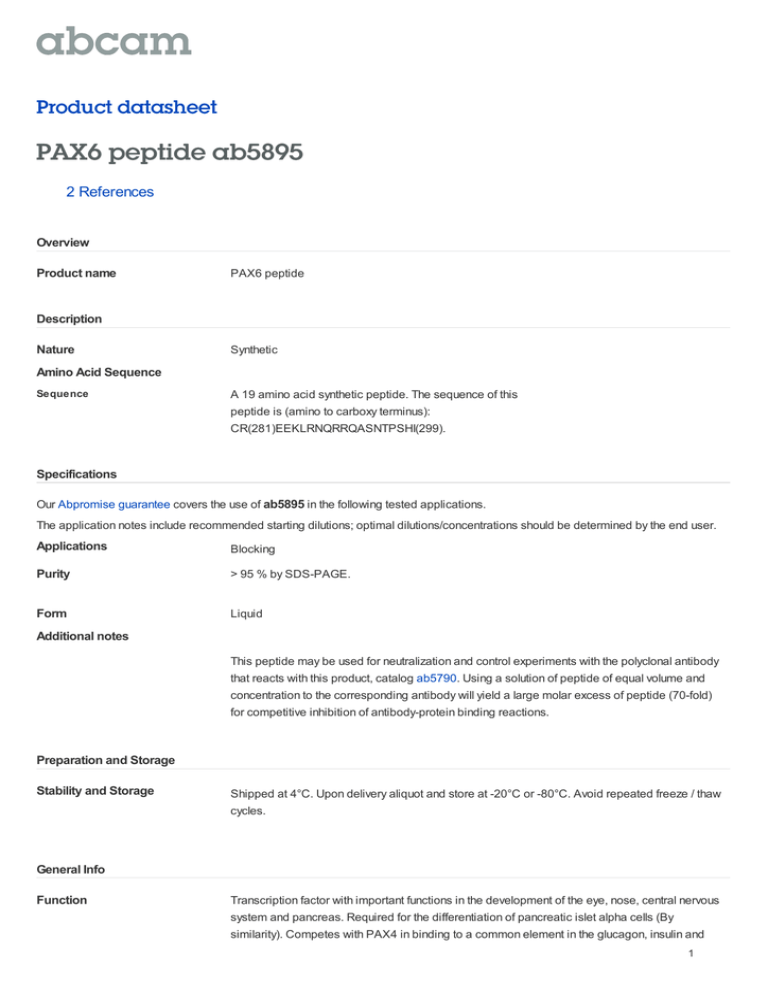
Product datasheet PAX6 peptide ab5895 2 References Overview Product name PAX6 peptide Description Nature Synthetic Amino Acid Sequence Sequence A 19 amino acid synthetic peptide. The sequence of this peptide is (amino to carboxy terminus): CR(281)EEKLRNQRRQASNTPSHI(299). Specifications Our Abpromise guarantee covers the use of ab5895 in the following tested applications. The application notes include recommended starting dilutions; optimal dilutions/concentrations should be determined by the end user. Applications Blocking Purity > 95 % by SDS-PAGE. Form Liquid Additional notes This peptide may be used for neutralization and control experiments with the polyclonal antibody that reacts with this product, catalog ab5790. Using a solution of peptide of equal volume and concentration to the corresponding antibody will yield a large molar excess of peptide (70-fold) for competitive inhibition of antibody-protein binding reactions. Preparation and Storage Stability and Storage Shipped at 4°C. Upon delivery aliquot and store at -20°C or -80°C. Avoid repeated freeze / thaw cycles. General Info Function Transcription factor with important functions in the development of the eye, nose, central nervous system and pancreas. Required for the differentiation of pancreatic islet alpha cells (By similarity). Competes with PAX4 in binding to a common element in the glucagon, insulin and 1 somatostatin promoters. Regulates specification of the ventral neuron subtypes by establishing the correct progenitor domains (By similarity). Isoform 5a appears to function as a molecular switch that specifies target genes. Tissue specificity Fetal eye, brain, spinal cord and olfactory epithelium. Isoform 5a is less abundant than the PAX6 shorter form. Involvement in disease Defects in PAX6 are the cause of aniridia (AN) [MIM:106210]. A congenital, bilateral, panocular disorder characterized by complete absence of the iris or extreme iris hypoplasia. Aniridia is not just an isolated defect in iris development but it is associated with macular and optic nerve hypoplasia, cataract, corneal changes, nystagmus. Visual acuity is generally low but is unrelated to the degree of iris hypoplasia. Glaucoma is a secondary problem causing additional visual loss over time. Defects in PAX6 are a cause of Peters anomaly (PAN) [MIM:604229]. Peters anomaly consists of a central corneal leukoma, absence of the posterior corneal stroma and Descemet membrane, and a variable degree of iris and lenticular attachments to the central aspect of the posterior cornea. Defects in PAX6 are a cause of foveal hypoplasia (FOVHYP) [MIM:136520]. Foveal hypoplasia can be isolated or associated with presenile cataract. Inheritance is autosomal dominant. Defects in PAX6 are a cause of keratitis hereditary (KERH) [MIM:148190]. An ocular disorder characterized by corneal opacification, recurrent stromal keratitis and vascularization. Defects in PAX6 are a cause of coloboma ocular (COLO) [MIM:120200]; also known as uveoretinal coloboma or coloboma of iris, choroid and retina. Ocular colobomas are a set of malformations resulting from abnormal morphogenesis of the optic cup and stalk, and the fusion of the fetal fissure (optic fissure). Severe colobomatous malformations may cause as much as 10% of the childhood blindness. The clinical presentation of ocular coloboma is variable. Some individuals may present with minimal defects in the anterior iris leaf without other ocular defects. More complex malformations create a combination of iris, uveoretinal and/or optic nerve defects without or with microphthalmia or even anophthalmia. Defects in PAX6 are a cause of coloboma of optic nerve (COLON) [MIM:120430]. Defects in PAX6 are a cause of bilateral optic nerve hypoplasia (BONH) [MIM:165550]; also known as bilateral optic nerve aplasia. A congenital anomaly in which the optic disc appears abnormally small. It may be an isolated finding or part of a spectrum of anatomic and functional abnormalities that includes partial or complete agenesis of the septum pellucidum, other midline brain defects, cerebral anomalies, pituitary dysfunction, and structural abnormalities of the pituitary. Defects in PAX6 are a cause of aniridia cerebellar ataxia and mental deficiency (ACAMD) [MIM:206700]; also known as Gillespie syndrome. A rare condition consisting of partial rudimentary iris, cerebellar impairment of the ability to perform coordinated voluntary movements, and mental retardation. Sequence similarities Belongs to the paired homeobox family. Contains 1 homeobox DNA-binding domain. Contains 1 paired domain. Developmental stage Expressed in the developing eye and brain. Post-translational modifications Ubiquitinated by TRIM11, leading to ubiquitination and proteasomal degradation. Cellular localization Nucleus. Please note: All products are "FOR RESEARCH USE ONLY AND ARE NOT INTENDED FOR DIAGNOSTIC OR THERAPEUTIC USE" Our Abpromise to you: Quality guaranteed and expert technical support Replacement or refund for products not performing as stated on the datasheet Valid for 12 months from date of delivery 2 Response to your inquiry within 24 hours We provide support in Chinese, English, French, German, Japanese and Spanish Extensive multi-media technical resources to help you We investigate all quality concerns to ensure our products perform to the highest standards If the product does not perform as described on this datasheet, we will offer a refund or replacement. For full details of the Abpromise, please visit http://www.abcam.com/abpromise or contact our technical team. Terms and conditions Guarantee only valid for products bought direct from Abcam or one of our authorized distributors 3
![Anti-PAX6 antibody [AD2.38] ab78545 Product datasheet 5 Abreviews 4 Images](http://s2.studylib.net/store/data/012574010_1-377b34cd10d44803d0297b3fb06ab73a-300x300.png)



